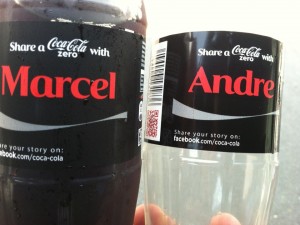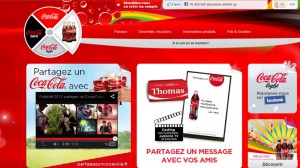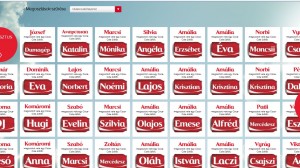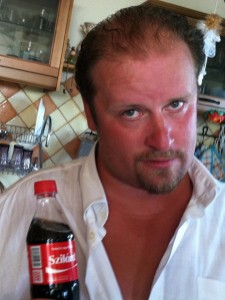
While traveling in Europe last month, I noticed that Coca-cola bottles were being sold with different peoples' names on them. I was intrigued enough to take a few pictures, and then I started looking for coke advertisements to see if I could pick up on a broader campaign.
While it piqued my interest, I became disappointed because I never once found a "John" or the equivalent across 4 different countries in 3 weeks, which was odd because my name (or the equivalent) is common in all European languages. Then one of my cousins in Hungary suggested that the idea was not to find my own name, but to make a new friend with each bottle. I heard what he said but I didn't quite get it, but since he is a marketer at an agency in Budapest that works with American brands, I figured he'd know something that I didn't about this campaign.

When I returned back to the USA last week, I heeded the call to action from my new bottle friends Marcel and Andre to share my story on facebook.com/coca-cola, but I didn't find any stories there about people making friends with soda bottles. When I went to the Coke website, I discovered by surfing to the European Coca-cola web pages that the campaign was launched only in Europe this summer. It turns out their European web pages are alive with virtual cans of people who are able to post the name of a friend on a Coke can. The problem I find is that it's not clear if these are real friends or bottle friends getting the virtual refreshments. And maybe that's deliberate. (?)

Their web pages also have maps showing places where Coca-Cola events are being held and it even lets you schedule a meet-up, which is interesting. But I couldn't imagine planning an event around a beverage. Maybe it isn't "just a beverage" and it's just me.
This kind of bold campaign is one that only a handful of global brands could pull off. I found the concept interesting, but I don't think it holds up in execution. For one, many of the locations where these products are sold just don't have enough shelf space to enable me to choose a name I'd recognize or associate with one of my actual friends.

As for the idea of associating a named soda with friendship or the good times shared with friends, I can't fully appreciate it because I can't get over the fact that once I've finished with the product, my friend ends up unceremoniously pitched into a recycle bin. That's just not the way I want to treat my friends.
Further digging yielded a story in the Huffington Post about this personalization campaign and how it has resulted in a customer backlash in some places, and even a lawsuit in Israel alleging discimination because of the choices of names they're using in that country. Other issues focus on the fact that personalization just seems contrived when it's executed on a mass-market basis such as this. I do think there's a point in that perspective, but I think a bigger lesson is a related one in that personalization is usually about the customer experience being tailored closely to the customer and it's not about how the brand wants to engage with the audience. Maybe an iconic brand like Coke is an exception and the problem is that I am not a big enough Coke fan for this to resonate enough with me. But for the rest of the world of marketing, it's now about the customer and not your product. Period.
So if you can't sell your products with peoples' names printed on the packaging, don't give up! Working toward personalized customer experiences is not out of reach! For ideas on how you can drive toward personalization in the customer experience, please download this whitepaper, Leverage Marketing Analytics to Improve the Customer Experience. And as always, thank you for following and please share your favorite beverage story or friend story in a comment below.

5 Comments
I live in Ireland and the way that I have seen this working is that people will tend to buy a coke with their friends / their own name on it then post it to Facebook - people are always on the hunt for their own name so it's defiantly effective!
I am more curious as to whether coke are using analytical techniques to determine the placing of bottle: they are doing it at a country level - ie John mark Phillip in England, but are they looking at particular geographies based on locations - I think analysis of Facebook locations would be a good way of doing this - perhaps they will divulge information on this at some point!
Hi Damian,
I figured there was more to it than meets the eye and I'm glad to hear people are doing that because it seems like that's the point. I agree with you about the analysis behind it - it would be fascinating to understand how they planned it, among other reasons because there are some multilingual countries like Belgium and Spain where language, culture and names are very sensitive topics.
Thanks for commenting!
JB
In Belgium, the 150 most common names between 1983 and 2000 were chosen. Names where excluded that are brand names and the name Mohammed was also excluded to prevent possible negative reactions.
Hi Mark,
That's interesting to know about Belgium. I wonder if their named products were distributed differently in Flanders versus Wallonia, or if how they distributed the different names impacted sales patterns.
Thanks for your comment!
JB
Just sharing additional detail about this campaign from this article in the Times of Israel. This was contributed as a comment by Ariella Brown on a syndicated posting of this blog post at AllAnalytics.com. Here is the original article link: http://www.timesofisrael.com/sharing-a-coke-using-israeli-tech/
------------
The Coke campaign, called "Share a Coke," was launched May 1, and has already proven to be one of the most popular by Coca-Cola in recent years, a company spokesperson said. The centerpieces of the campaign are the "individualized" bottles consumers can buy, with their names on the label. The bottles are not produced to order; rather, the company said, the bottles use a range of about 150 of the popular first names of residents of each country (mostly in the younger demographics) where the campaign has been running. There are also nicknames, as well as generic titles, like, husband, wife, boyfriend, etc.
The campaign is running in 32 countries, and by the time it ends after the summer, some 800 million "name bottles" will have been distributed, Coke said. Test campaigns ran in Australia (2011) and New Zealand (2012), and were considered big successes by Coke. The campaign includes not just personalized labels, but a whole web campaign, with consumers "sharing" a coke online, and even flashing the names of customers who register at a Coke website on digital billboards in New York's Times Square.
But the label is the centerpiece of the campaign, and getting those labels printed proved to be a major challenge for Coke. Although the company has been printing labels by the billions for decades, this printing job was different, company officials said. Personalized label printing – meaning, changing the text or design of a label – is different from conventional label printing, in that it requires changes to the print run to be made "on the fly," without shutting down label production and recalibrating the printing equipment to change the name on the label.
Coke generally handles its own label printing, industry reports quoted company officials as saying, with equipment that is set to print the "normal" labels of Coca-Cola, Diet Coke, and Coke Zero — Coke's three main offerings. That's only three labels. But in the new campaign, Coke needed to be able to turn out, on schedule, 150 or so separate labels, for 32 markets – or close to 5,000 different labels.
It was a major challenge for the company, said Marit Kroon, marketing manager of Coca-Cola Europe, and after much experimentation, the company decided to print all the labels on HP Indigo printers, developed in Israel by the Indigo division of HP.
------------